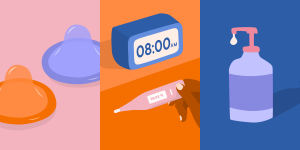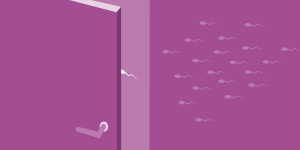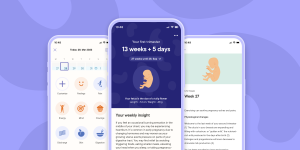Photo by Franz Grünewald, Art direction by Marta Pucci
When to stop taking hormonal birth control if you want to get pregnant
A method-by-method breakdown.

Top things to know about coming off hormonal birth control to become pregnant
Most people who stop taking birth control to try to become pregnant are successful within the first year
For some types of birth control, there can be a temporary delay in becoming pregnant
The delay one may experience depends on the method of birth control used
To become pregnant, you need to have sex on the days in your cycle when conception is possible
Many of us spend years of our lives using birth control. But what happens if you decide you’d like to conceive? In this article, we will review the different kinds of birth control and what happens when you stop using them to try to become pregnant.
Will hormonal birth control affect my ability to become pregnant in the future?
No. Many people will conceive in just a few months after going off birth control, and the majority will become pregnant within a year (1-3).

How long does it take to become pregnant after stopping hormonal birth control?
One of the main ways hormonal birth control prevents pregnancy is by stopping ovulation (the release of an egg from one of the ovaries ) (2). Once hormonal birth control is stopped or removed, ovulation usually returns along with the chance to become pregnant (2).
How long it can take to conceive after going off your hormonal birth control depends on the specific method you were using. Some forms of hormonal birth control take longer to leave the body than others.
Becoming pregnant after going off the shot, for instance, may take longer than becoming pregnant after removing an IUD (4-6).
Below, we break down each method in detail and how soon after stopping use you may be able to become pregnant:
The hormonal IUD
Pregnancy possible within a few months after removal
Hormonal IUDs are inserted into the uterus and release the progestin levonorgestrel, a synthetic form of the hormone progesterone (7). The progestin in the hormonal IUDs primarily prevent pregnancy by thickening the cervical mucus, stopping the growth of the endometrium (lining of the uterus), and impairing sperm function by changing the environment of the uterus (8-10). The hormonal IUD sometimes prevents ovulation from happening, but this isn’t always the case (11). If ovulation is not already happening, it should return quickly after the hormonal IUD is removed (12). Conception is possible as soon as the hormonal IUD is removed (6). The chances of conceiving within one year after using a hormonal IUD is the same as using no birth control at all (1).
The copper IUD
Pregnancy possible within the first month after removal
The copper in the IUD prevents pregnancy by changing the environment in the uterus and making it difficult for sperm to move and for fertilization to happen (13,14). Because the copper IUD is non-hormonal, the ability to become pregnant returns faster. Pregnancy can happen within the first month of removing the copper IUD (1).
Combination pills
Pregnancy possible immediately or within the first few months after stopping
Combination pills contain a combination of the hormones ethinyl estradiol and progestin, the synthetic versions of estrogen and progesterone (15). Ovulation usually returns immediately after stopping the combined pill, and one study showed that most people saw their “natural” period (not a withdrawal bleed) return about a month after stopping the pill (16). Studies show that many people will conceive within the first few months of stopping the pill, and between 72–94% within 12 months (17,18).
The shot
Pregnancy possible within three months to a year after your last shot
The most common form of injectable birth control available in the United States is Depo-Provera. It contains progestin only and is taken every three months (4). Although not available in the United States, short-term injectable contraceptives are popular methods in China, Eastern Asia, and Latin America. They’re taken every month and contain progestin and a form of estrogen (19,20). Injectable contraception is usually injected into the muscle which acts as a storage area for the drug. Therefore, there may be a delay in the ability to conceive after stopping the shot (4,5). Because of the delay in the return to fertility, healthcare providers may recommend discontinuing injectable birth control 12–18 months before the time pregnancy is desired (2).
Studies show that ovulation may return anywhere from 3 months to a year after your last shot (2,3). The large range can make it difficult to know how long it can take to become pregnant. Tracking your cycle and signs of ovulation can be helpful in identifying when ovulation has returned and conception is possible.
The implant
Pregnancy possible in a week after removal
Birth control implants are inserted under the skin on the upper arm and release progestin (21). The hormone from the implant will be cleared from the body within a week of removal (2,22). Ovulation usually returns within 3–4 weeks (22). Studies have shown that pregnancy can occur as early as 1–2 weeks after removal (22). Pregnancy rates one year after removal of the implant are similar to pregnancy rates after stopping other forms of birth control (2)
Progestin-only pills (the “mini-pill”)
Pregnancy possible immediately after stopping
Unlike the more common combination pill that contains an estrogen plus progestin, the mini pill contains only a progestin and is taken everyday at the same time without a break (23). It is often prescribed to people who have recently given birth and who are breast/chestfeeding (2). Ovulation usually returns immediately after stopping progestin-only pills (24).
The ring
Pregnancy possible two weeks after removal
The ring is a clear flexible ring about 2 inches (5cm) wide that is self-inserted into the vagina for 21 days and removed for a 7 day break after which a new one is inserted (25). The ring releases ethinyl estradiol and etonogestrel, a progestin (25). Ovulation is estimated to return within 17–19 days after removing the ring (2). One large study suggested that within three menstrual cycles of stopping the ring, the ability to conceive is similar to those who stop using barrier methods like condoms (26).
The patch
Pregnancy possible within the first month after stopping
The patch is a thin square sticker which has both estrogen and progestin in it (25). It is about 2 inches (5cm) wide that is placed on the skin on the stomach, upper arm or back (25). The patch is replaced every week for 3 weeks, followed by a week long break and withdrawal bleed (25). The patch releases ethinyl estradiol and norelgestromin, a progestin, and primarily prevents pregnancy by stopping ovulation (2). Ovulation usually returns within the first month after stopping the patch (27). A large study showed that after four menstrual cycles, there isn’t a difference in the ability to conceive, between those who stop using the patch and those who stop using barrier methods like condoms (26).
Does using emergency contraception (the morning-after pill) affect my ability to conceive in future?
Emergency contraception prevents pregnancy in the same way as hormonal birth control—by preventing ovulation from happening in the cycle you take it in (28). According to the World Health Organization, taking emergency contraceptive pills does not affect the ability to become pregnant in the future (29).
If I had my tubes tied, can I still become pregnant if I want to?
The fallopian tube is where fertilization (when sperm and the egg meet) occurs. Getting your tubes tied (tubal ligation or tubal removal) is designed to be permanent. If you want to try and become pregnant, it’s possible to have the procedure reversed if there is enough functional and healthy tube available, but this does not automatically mean you can become pregnant (30). In general, research suggests 42% to 90% of those who have the procedure reversed will be able to become pregnant within 2 years (30).
Reversal depends on (30):
your current age
how the tubes were tied or removed,
how long it has been since they were tied,
and how damaged the tubes are.
Getting pregnant after any surgery on the tubes increases the risk of ectopic pregnancy (30). Another option for pregnancy after getting your tubes tied is in vitro fertilization (IVF) (31,32).
When should I see a healthcare provider?
You should consider speaking to your healthcare provider if (33-35):
You stopped your birth control method and have not had a period for 3 months. There may be other reasons why your cycle has not returned, such as PCOS, that were hidden while on birth control.
You are 34 or younger and have been trying to become pregnant for 12 months.
You are 35 or older and have been trying to become pregnant for 6 months.
You are 40 or older and plan to become pregnant.
Remember: To become pregnant, you need to have sex on the days on your cycle when conception is possible. You can use Clue Conceive to get preconception health information, track your cycles, and get personalized predictions to time sex or home insemination to try and become pregnant.
An earlier version of this article was published September 6, 2019, with financial support from Bayer.




